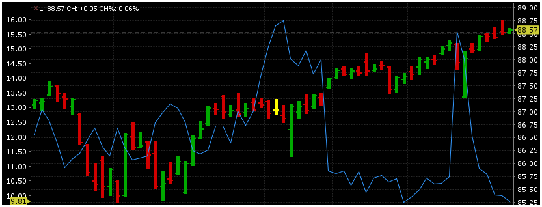Since 1997, a two-factor model incorporating the Chicago Fed National Activity Index ( CFNAI ) and high yield spreads (the difference between the yield of a high yield bond and that of the 10-year U.S. Treasury) explained nearly 60% of the variation in the VIX. Adding the Uncertainty Index to the model does not improve its efficacy. Right now both leading indicators and credit markets are suggesting what most investors intuitively realize: The VIX should be low, although arguably not as low as 10. The two-factor model suggests fair value for the VIX somewhere in the mid-teens, roughly where it peaked last week. To the extent credit markets take the events in Washington in stride-even during the worst selling last week high yield spreads remained comfortably below 400 basis points (4%)-equity investors can breathe a little easier, at least until they can’t. Read more

Notice the last sentence (in bold) in the above paragraph. It means that the credit market was calmer during the “panic” 2 weeks ago.
Another article by Dave Sekera of Monrningstar corroborates this observation:
All the political commotion in Washington had little impact on credit spread trading levels in the corporate bond markets last week. The average spread of the Morningstar Corporate Bond Index (our proxy for the investment-grade bond market) widened only 1 basis point to +118. In the high-yield market, the Bank of America Merrill Lynch High Yield Master Index widened slightly in sympathy with the sell-off in the equity markets midweek but quickly rebounded. By the end of Friday, the average spread of the high-yield index was only 1 basis point wider, closing at +378. Among the underlying sectors in the high-yield space, energy performed relatively well, tightening 6 basis points. The outperformance of the energy sector was driven by the price of oil, which rose $2.60 to about $50.50 a barrel, back to the middle of its trading range over the past six months. In the equity market, after being down as much as 1.42% midweek, the S&P 500 recovered most of its losses and ended the week down only 0.38%. The greatest movement over the course of the week was in the Treasury bond market. Investors sought a safe haven in the Treasury market, bidding up prices and sending yields lower. Interest rates on 5-year, 10-year, and 30-year bonds dropped 7-10 basis points, bringing yields down to 1.78%, 2.23%, and 2.90%, respectively. Read more
But why did the high yield spreads not react strongly as the volatility index. Was it because the VIX was undervalued and the high yield spreads fairly valued?
We think that stronger evidences can be found elsewhere, for example, to name a few, a high level of short interests of volatility ETFs or the increased leverage and position size.
ByMarketNews

No comments:
Post a Comment